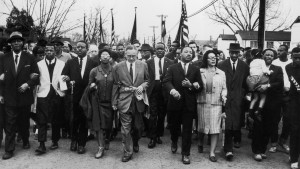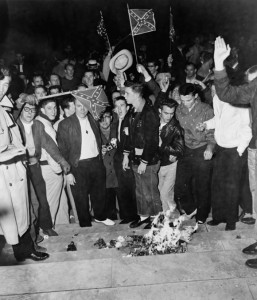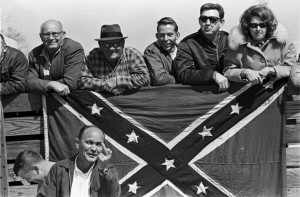Recently, a former student of mine, Dale Swearingen, posted the following on Facebook:
“I just want to post this as a discussion point: If the Confederate flag should be removed because it’s mostly being linked to racism and violence, then shouldn’t we also remove our current flag due to the slaughter of hundreds of thousands of Native Americans?”
Let me first point out that this is a fine example of how to approach a difficult and controversial subject. How we say what we say is as important, I believe, as what we say. Dale’s post is not accusatory, insulting or overbearing. It invites discussion and reflection. Civic discourse — the way we talk about social issues in public — is actually quite important. As historian Tracy McKenzie points out in The First Thanksgiving, all too often we use history or civic discourse for the purposes of ammunition rather than illumination. I’m guilty of that too often, myself.
Second, a short answer to Dale’s question is that while it is true that both flags point to a history linked to racism and violence, there is still a significant difference between the two. The American flag has been used to justify unjust situations, but it has also been used, historically, by the oppressed in American society to remind Americans that we are still not as just as we could be. It was carried by black civil rights leaders in all the key civil rights moments, including the march in Selma. Native Americans commonly fly the American flag at events tied to their identity, such as Indian rodeos. Cesar Chavez, who worked for the rights of poor Mexican-American farm laborers was often pictured in front of the flag. It is a flag that has been embraced by just about all American communities. (Jehovah Witnesses and the Amish are exceptions, for theological reasons.) Some members of these communities have protested against the American flag or seen it as a sign of oppression, but they tend to be minorities within their own communities.
However, when have blacks, Native Americans, immigrants, religious minorities or other “outsider” groups working for justice flown the Confederate flag? What causes for justice has the Confederate flag stood for? Some fly it for the cause of states rights, or the cause of southern whites who feel marginalized, or vague principles of being a “rebel” against the establishment. But these have been narrow and limited causes. And they have all been bound up in racism. Am I missing a bigger cause that the Confederate flag stands for that includes all Americans?
So there is, I believe, a qualitative difference in the ways the two flags have been used in American society. When the day arrives where whites and blacks march together with the Confederate flag for causes against some sort of evil or injustice — particularly against racism –then I will start to change my view of the overall cultural meaning of the Confederate flag.
But even that response, while valid, does not get at all the issues.
There is another, deeper, more sobering point that all Americans need to consider. Dale’s question gets at a hard but an important historical question for all of us who are Americans: what about the injustices that have been tied to the actions of the American nation? It’s possible for white northerners to argue about the Confederate flag in a way that puts all the hard ethical, social and relational work on someone else. But addressing racism and race relations in our society is hard work that applies to all Americans.
One way to think about Dale’s flag post is to consider the way that the word “heritage” is often used. Some have argued that the flag (and this applies to both the Confederate and American flags) has been used for racism or hate, but that is not what the flag is really about. It’s really about our heritage. And heritage is about what is good in our past. Therefore, both the American flag and the Confederate flag are really about noble ideals.
That can be a tempting route to take because it is optimistic and easy to understand.
Too easy. That understanding of heritage produces national denial. It pains us to see a friend or a loved one deny that they have a problem when it is clear they are struggling with something like addiction. Similarly, it should pain us to see our culture in denial when struggling with a social problem like racism.
Slavery. Indian Removal. Discrimination against immigrants. Gender inequities. Segregation. Religious discrimination. These are inescapable aspects of American history. As such, they are part of our heritage, just as much as the Bill of Rights, religious freedom, economic opportunity, and votes for women are part of our heritage. Furthermore, the American heritage of racism would not be a great problem if we were at a point today where we have figured out racial problems. We haven’t. So let’s try to understand the problem better. You can’t do that, fully, without understanding history.
Others have said that the flag is a sign of hypocrisy. American history is full of people in power who have preached justice, equality, and freedom, while denying it to those outside of their group. Therefore, the flag is about historic injustices.
That can be a tempting route because it takes a strong stand on justice and is easy to understand.

A good book to read if you want to get all fired up about injustices in America’s past. And feel self-righteous about it.
Too easy. That understanding removes me from having to search myself for any connection to injustice. That makes it pretty easy to be self-righteous. You can do this if you are white, by the way. Just identify with the oppressed in America’s past in such a way that enables you to say that the collective problems of injustice in America are caused by other people, or groups that you don’t identify with. The historian Howard Zinn tended to write history this way. If you have ever run into his books you see he presents a searing critique of the United States. (Actually, his work is a bit more complicated than that because of his Marxist worldview, but I think the basic stance still holds). He was provocative, which can be helpful, but mostly I found it was too easy to agree with him in a way that produced self-righteousness.
Nobody likes to face sin within themselves. In the same way, we don’t like to face sin in those in history we identify with. And who, from the past do we identify with? Southerners, blacks, whites, Catholics, evangelicals, Jews, workers, women, Indians, Democrats, Republicans, immigrants, business leaders — there are many, many options here. But we’ll instinctively and unconsciously want to defend those we identify with, while ignoring their sins. That’s one way we sin.
Christians ought to be good at confessing the sins of those we identify with. Alas, I confess that we are not always good at this. I include myself in this. We ought to be good at confessing the sins of Christians in the past because we believe that sin infects all of us. We Christians ought to be good at this because we should be humbly and sincerely confessing our own sins on a regular basis. And we Christians ought to be good at this because we know that, by the grace of God, we are forgiven when we confess our sins. And Christians we ought to be good at this because we know that through this grace, God transforms us into more of what we should be.
So where does that leave our discussion on history and the flag? I’ll say this about the United States: it is a land that has been deeply stained by slavery, segregation and racism, but it is also a land that has provided opportunities to address these evils. Democracy doesn’t make us good, but it can provide the freedom for good people to address injustices, sins, and problems within society. And it can give us the freedom to try to change them. It’s not easy, but we have the freedom to do the hard work. The problem is that we also have the freedom to completely ignore the hard work. (Hey, do you want to play a video game or go the mall?)
A truly good patriot and good Christian, then, does not deny the sins in America’s history. A good patriot and good Christian will soberly look at America’s history to gain deeper understanding about how past sins have been effectively addressed and what, historically, has brought about justice, freedom and equality in an American society stained by sin. And a good patriot and good Christian will then ask, how am I a part of a system, an institution, a way of thinking that is bound up in this?







